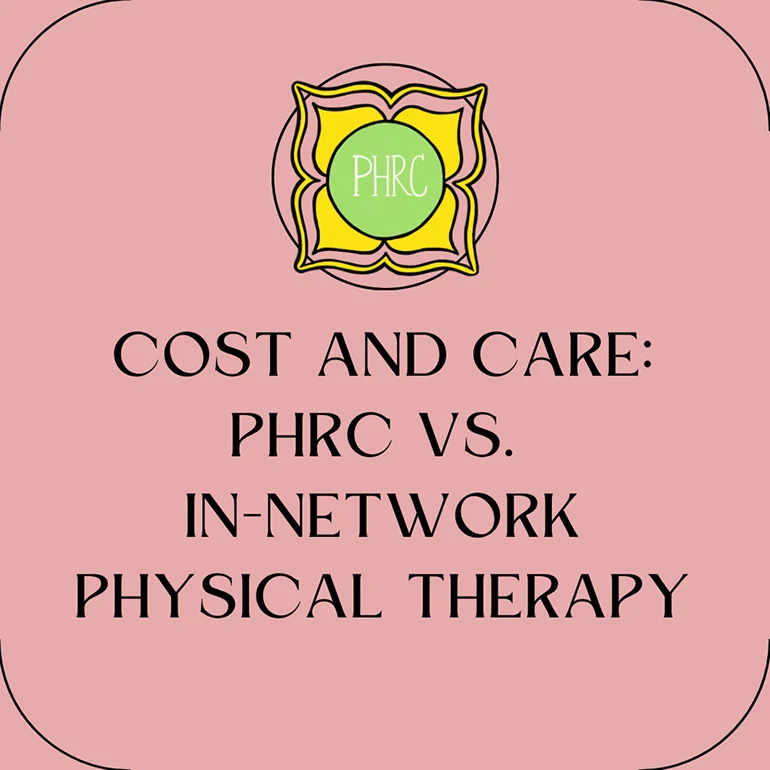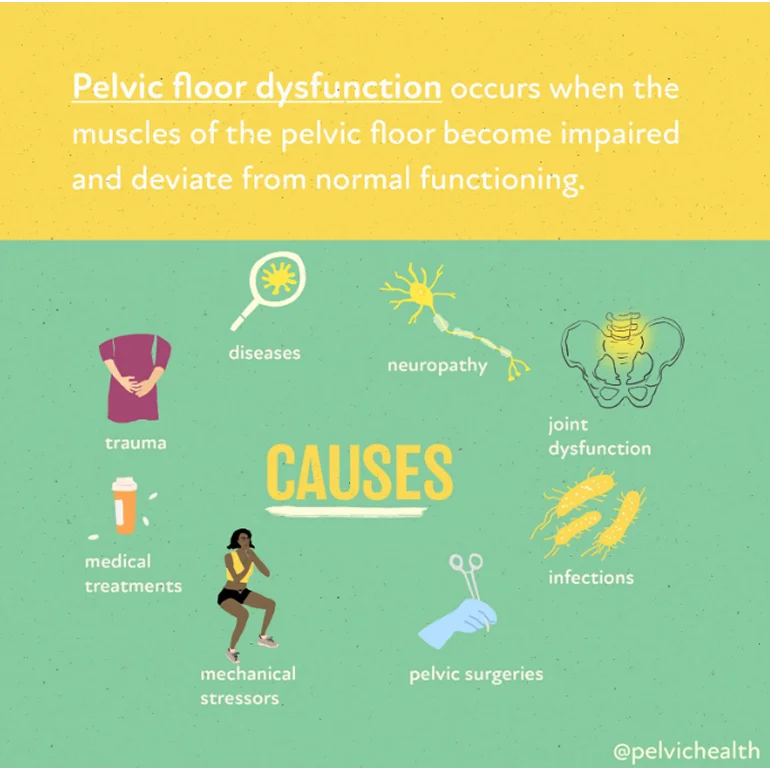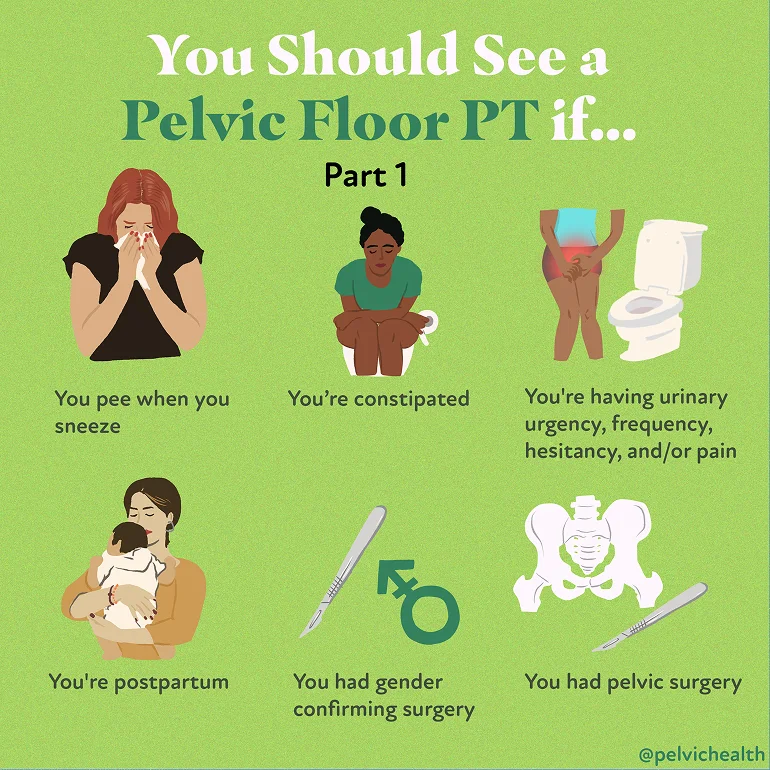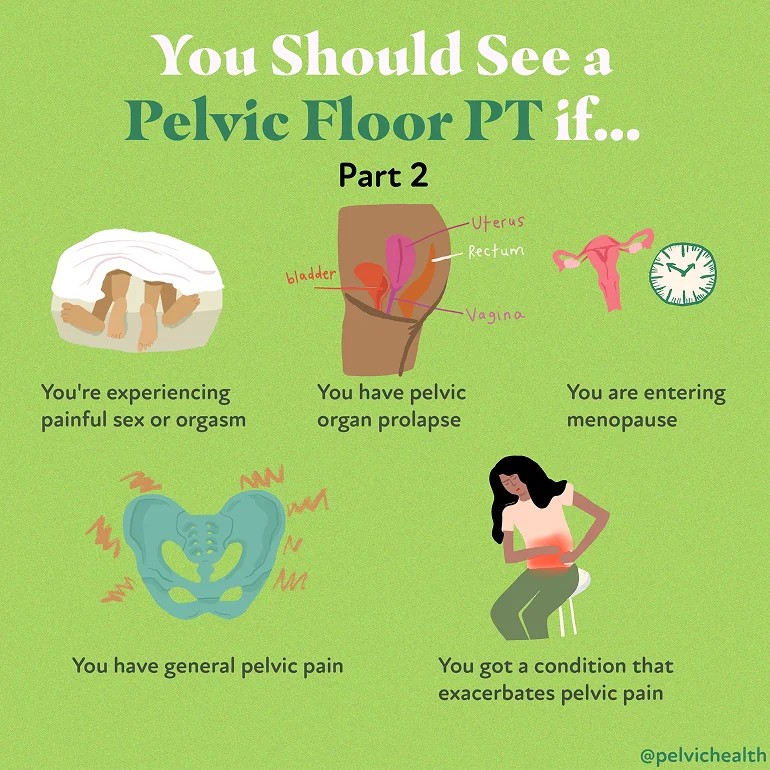Table of Contents
-
.
-
.
-
.
-
.
-
.
-
.
-
.
-
.
-
.
When Should I See a Pelvic Floor Physical and Occupational Therapists?
-
.
When it comes to pelvic floor physical therapy, cost is often one of the first things people ask about. However, the cost for an appointment is simply one piece of the bigger picture. While “in-network” physical therapy might initially seem to have a lower cost, the type of care you receive and the frequency of which you can receive it, the expertise of the provider, and the overall time it takes to see results can be very different.
At the Pelvic Health and Rehabilitation Center (PHRC), pelvic health is our specialty. Our team consists entirely of licensed pelvic floor physical and occupational therapists with advanced training in pelvic floor therapy, and we are recognized leaders in this highly specialized field. From treating complex pelvic pain conditions to collaborating with top physicians across the country, our focus has always been on delivering the highest level of care and lasting results for our patients.
This guide will help you understand what sets PHRC apart, what’s included in the cost of care, how we compare to in-network clinics, and why so many people choose us for their pelvic health needs.
What is Pelvic Floor Physical Therapy?
Pelvic floor physical therapy focuses on treating the muscles, tissues, and nerves in your pelvic region that support your bladder, bowel, and reproductive organs. These muscles also play an important role in controlling urination, bowel movements, and sexual function. When they become too tight, too weak, or uncoordinated, it can lead to pain, pressure, or difficulty with everyday functions.
Pelvic floor dysfunction affects people of all genders and identities. Tight muscles can cause sharp, burning, or aching sensations that might radiate to the hips, low back, or tailbone. Weak or uncoordinated muscles can create a feeling of heaviness, pulling, or even issues like leakage or constipation.
In pelvic floor physical therapy, your pelvic floor physical and occupational therapist will assess how your pelvic floor is working by examining muscle strength, coordination, and any areas of tension. Treatment often includes:
- Exercises to relax or strengthen the pelvic floor
- Manual therapy to release tight muscles or trigger points
- Guidance on improving movement patterns and posture
- A customized home program to support your progress
At PHRC, we customize therapy to your needs and coordinate with your other providers when necessary. The goal is to help you restore pelvic function, reduce pain or pressure, and regain confidence in how your body works—whether that’s in daily routines, exercise, or intimacy.
Do You Accept Insurance?
Yes, we accept various forms of a few insurances, depending on your location. We’ve outlined below how PHRC works with different insurance providers.
Brown and Toland Physicians
The Pelvic Health and Rehabilitation Center is part of the Brown and Toland Physicians network serving our patients in our Bay Area locations (San Francisco, Berkeley, Los Gatos, and Walnut Creek).
Kaiser Permanente (Northern and Southern California)
The Pelvic Health and Rehabilitation Center is an out-of-network, contracted provider with Kaiser Permanente of Northern California serving our patients in our Bay Area locations (San Francisco, Berkeley, Los Gatos, and Walnut Creek) and our Southern California locations (West LA and Pasadena).
Harvard Pilgrim Health Care
The Pelvic Health and Rehabilitation Center is now part of the Harvard Pilgrim Health Care network, serving our patients in our Merrimack, New Hampshire and Lexington, Massachusetts locations.
Medicare
The Pelvic Health and Rehabilitation Center (PHRC) is a non-participating Medicare provider. Non-participating providers accept Medicare but do not agree to take assignment in all cases. This means PHRC accepts Medicare insurance but does not consider Medicare’s approved amount as full payment for services.
As a non-participating provider, PHRC may charge up to 15% above Medicare’s approved amount for services (referred to as the “limiting charge”). This means patients are responsible for up to 35% of the Medicare-approved amount:
- 20% coinsurance
- 15% limiting charge
Patients are required to pay the full cost of their care upfront. However, PHRC will submit a bill to Medicare on the patient’s behalf. Once processed, Medicare will issue the patient a Medicare Summary Notice (MSN) and reimburse them for 80% of the Medicare-approved amount.
Our team is here to answer any questions you might have related to insurance coverage.
What You’re Really Paying For with PHRC
When you choose PHRC, you’re investing in more than just physical therapy sessions. You’re paying for:
- Specialized expertise from pelvic floor physical and occupational therapists who focus solely on pelvic health
- Extended one-on-one sessions with your dedicated pelvic floor physical and occupational therapist at every visit
- Comprehensive evaluations that go beyond quick, surface-level assessments
- Personalized treatment plans designed for your unique symptoms and goals
- Hands-on manual therapy to address muscle tension and trigger points directly
- A guided home program to help you stay on track between visits
- Collaborative care where we communicate with your other providers as needed
- In-person and virtual appointments available to make access to care seamless and easy
- Supportive, private environments where your comfort and progress come first
At PHRC, we combine focused expertise with a whole-person approach so you can achieve lasting results and regain control of your pelvic health.
Cost Comparison: PHRC vs In-Network Physical Therapists
At first glance, in-network physical therapy appears less expensive because insurance often covers a larger portion of each visit. However, many patients discover that those savings come with trade-offs in the quality, time, and focus of care they receive.
In-network clinics often operate on volume. This means appointments are very short (typically only 20 to 30 minutes). This model leaves little time for hands-on treatment or meaningful conversation with your pelvic floor physical and occupational therapist—and often results in slower progress and more total visits.
PHRC takes a very different approach. Every visit is a full one-on-one session with a highly trained pelvic floor physical and occupational therapist. We dedicate time for a thorough assessment, hands-on manual therapy, exercise instruction, and plan adjustments. We listen carefully, tailor your care, and move at a pace that prioritizes real, lasting improvement. We have deep and close connections with medical professionals in our local areas and pride ourselves on ‘quarterbacking’ care for our patients so they no longer have to navigate care themselves.
What truly sets PHRC apart, though, is our depth of specialization. Every pelvic floor physical and occupational therapist at PHRC has residency-level training in pelvic floor therapy. This exclusive focus allows us to integrate pelvic floor and pelvic girdle physiology in a way that restores function across the entire body. We draw from a deep well of experience that only comes from treating complex pelvic health conditions day in and day out.
We also embrace an interdisciplinary approach. Many people with pelvic floor dysfunction benefit from collaborative care with gynecologists, urologists, gastroenterologists, orthopedists, psychologists, and others. We’ve built strong relationships with providers across the country so we can easily loop in trusted partners. Once your care team is in place, we act as the “CEO” of your treatment—coordinating care, leading communication, and making sure all providers are aligned and working toward your goals.
PHRC has also become a recognized leader in pelvic health education. Our team frequently speaks at hospitals, universities, and international medical conferences. Stephanie Prendergast, one of our founders, became the first physical therapist to serve as President of the International Pelvic Pain Society in 2013. We regularly teach community classes, mentor students, and write an award-winning blog, As the Pelvis Turns. In 2016, we published our first book, Pelvic Pain Explained.
Our commitment to staying at the forefront of pelvic health research, combined with the hands-on, individualized care we provide, is what makes PHRC different. While our services are often an out-of-pocket investment, our patients consistently tell us it’s worth it—for the results, the attention, and the expertise they couldn’t find anywhere else.
How To Know If PHRC is Right For You
If you’ve been struggling with pelvic health issues and haven’t found the answers or relief you need, you’re not alone. At PHRC, we specialize in treating a wide range of pelvic conditions with personalized, one-on-one care that meets you where you are. Whether your symptoms are new or you’ve been dealing with them for years, we’re here to help.
If you experience any of these symptoms or conditions, we can help:
- Pelvic pain
- Clitoral pain
- Male pelvic pain
- Hard flaccid
- Sexual dysfunction
- Bowel dysfunction
- Bladder dysfunction
We also provide specialized care for:
- Endometriosis
- Interstitial cystitis
- Pudendal neuralgia
- Pelvic organ prolapse
- Pregnancy and postpartum
- Menopause and perimenopause
- Post-surgical rehabilitation
- Pediatric pelvic health
- Transgender pelvic health
At PHRC, we create treatment plans tailored to your specific needs and goals, so you feel supported every step of the way.
How Long Does it Take To See Results?
The timeline for improvement varies because every person’s condition and goals are unique to them. Some patients begin to notice changes within just a few sessions, while others with more complex or long-standing symptoms need several months of consistent care to see meaningful progress.
At PHRC, we draw on our deep experience treating a wide range of pelvic floor conditions to create a plan that’s realistic and effective. Because our sessions are longer, highly focused, and one-on-one with a pelvic floor physical and occupational therapist, many patients experience faster results compared to shorter, generalized in-network visits.
We continually reassess your progress and adjust your treatment as needed. Our goal is not just temporary relief, but lasting improvements in your function, comfort, and quality of life.





